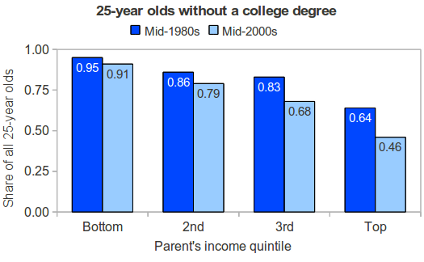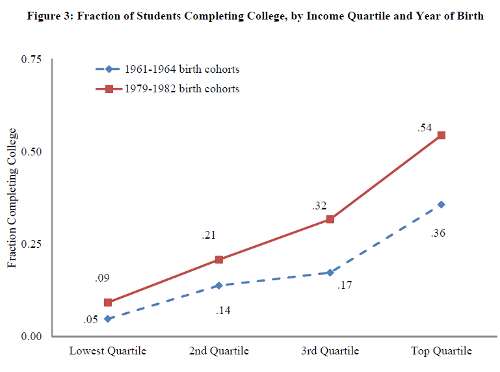March 01, 2012
The central issue in the furor that erupted a few weeks back over the “Gatsby Curve” was whether or not the sharp increase in inequality over the last three decades has depressed economic mobility. President Obama, the chair of his Council of Economic Advisers, and most of the leading experts in the field argue that today’s extreme inequality is not only bad in itself, but it also lowers economic mobility. Brookings Institution fellow Scott Winship, however, says mobility is no worse today than it was earlier in recent economic history.
Winship’s critique of the standard view on declining mobility centers on what he sees as limitations in the available data and problems with the statistical techniques used by economists analyzing the recent trends. At this point, quite a few people have offered responses to Winship’s technical concerns (including one of us (pdf) at a recent event sponsored by the New America Foundation). But, most of this recent debate has been confined to a fairly narrow (and generally technical) discussion of Winship’s criticisms of the way surveys capture, and the way economists model, income.
A recent paper (pdf) by Martha Bailey and Susan Dynarski, however, allows us to completely sidestep Winship’s concerns about measuring income across generations. Bailey and Dynarski analyze college completion rates over time and find a disturbing pattern that provides strong support for the view that economic mobility has declined substantially over the last three decades.
Source: Author’s calculation based on data from the National Longitudinal Survey of Youth. 1979 and 1997 (U.S. Bureau of Labor Statistics, 2010a. 2010b)
Bailey and Dynarski used two data sets, one that followed people born in the early 1960s (1961-64) and the other that followed people born in the late 1970s and early 1980s (1979-82). For each of the two initial periods, the economists divided families into four equal-sized groups by income, from lowest to highest. Then, they asked how many children in each of these income fourths had completed a four-year college degree 25 years later. For the group born in the early 1960s, 5 percent of the children born into the poorest fourth of families had finished college by age 25, compared with 36 percent of those in the richest fourth of families. For the group born about 20 years later, in the late 1970s and early 1980s, 9 percent of those born into the bottom forth had finished college by age 25, compared with 54 percent for those children born into the top quartile.
It is hard to interpret these numbers as anything other than making a strong case that mobility is a lot lower for the children of the 1980s than it was for the children of the 1960s, especially given the large increase between the 1980s and the 2000s in the earnings of college graduates.
To see this point most easily, it helps to invert the numbers in the Bailey and Dynarski chart. The figure below shows the share of each quartile that does not have a four-year college degree by age 25. For those born into the lowest income families in the 1960s and trying to make their way into the top quartile later in life, 95 (out of 100) did not have a college degree. These non-college-educated young people born to low-income families in the 1960s were competing for slots in the top quartile with the 64 (out of 100) non-college-educated young people and 36 (out of 100) college-educated young people born into families in the top fourth of families.

Source: Bailey and Dynarski (2011), Figure 3.
For those born into the bottom quartile almost 20 years later, the odds were much worse. Now, there were 91 (out of 100) without a college degree –a slight improvement over the situation for the earlier generation. But, these 91 non-college-educated young people born into low-income families were competing for top slots against 54 (out of 100) college graduates –not 36 (out of 100) barely two decades earlier.None of this evidence depends on how we measure income (except to assign children into the initial family income distribution) or on any modeling needed to overcome limitations in the data. And the education data leave little doubt that it is much harder for low-income children born in the 1980s to get ahead than it was for low-income kids born in the 1960s (when, of course, it wasn’t very easy either).








